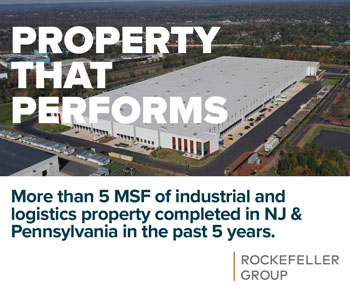From left: Rob Kossar, vice chairman with JLL; Morris Davis, the Paul V. Profeta chair of real estate and academic director at the Rutgers Center for Real Estate; Will Irving, an associate professor of practice at Rutgers University’ Edward J. Bloustein School of Planning and Public Policy; and Jeff Otteau, managing partner and chief economist of Otteau Group, served as panelists at NAIOP New Jersey’s Annual Meeting and Commercial Real Estate Outlook on Jan. 25. — Courtesy: Linda Lindner/ROI-NJ
By Joshua Burd
The state’s industrial and office sectors both faced headwinds in 2023, but the year ahead for each asset class may be decidedly different.
That was a key takeaway last week from panelists at NAIOP New Jersey’s Annual Meeting and Commercial Real Estate Outlook, who noted that demand for warehouse and logistics space has normalized after a record-breaking run during the pandemic. Office landlords, meantime, are still grappling with shrinking corporate footprints and remote work policies, further straining submarkets that are both aging and oversupplied.

“Net absorption is not trending higher in office,” said Richard Barkham, CBRE’s global chief economist, referring to how the market measures changes in occupancy. “There are still active tenants in the market … (but) the trend is down.”
He sees a brighter near-term future for industrial space — which saw rent growth moderate and a pullback in preleasing in 2023 — amid the “soft landing” that many economists are forecasting after a period of rising interest rates.
“As prices come down and occupiers see the opportunity to do good deals, I do see industrial absorption coming back a lot more strongly than it has in recent quarters,” said Barkham, CBRE’s head of global research and head of Americas research.
He spoke Thursday as NAIOP New Jersey members gathered for one of the commercial real estate association’s largest events of the year. The meeting drew a registered crowd of around 300 for a program that included the election of new chapter officers and trustees, Barkham’s keynote and a subsequent panel discussion moderated by Rob Kossar, a vice chairman with JLL.

Jeff Otteau, managing partner and chief economist of Otteau Group, said commercial real estate felt “significant impacts” in 2023 despite the economy’s resilience against the Federal Reserve’s interest rate hikes. That was most evident in the investment sales market, he said, citing a 60 percent drop in deal volume in New Jersey from more than $13 billion to $5 billion.
“What we saw this past year is that, for a buyer to buy or a seller to sell, there needed to be a compelling reason for them to decide to go forward in this high-interest-rate environment,” said Otteau, who also serves as managing broker of Hudson Atlantic Realty Advisors. “That compression was fairly widespread across all various sectors and, as a result of that we saw, for the first time since the Great Financial Crisis, a decline in commercial asset values in terms of trading prices.”
Surprisingly, he said, the largest decline by asset class was in multifamily assets, while trading prices for retail properties increased.

“There is more of it to come in terms of price declines,” Otteau added. “But it will be more gentle this year than last year because the Fed has signaled that we can expect to see interest rates decline slowly and that will relieve some of the downward pressure.”
Barkham noted during his keynote that vacancy rates in the multifamily, retail and industrial sectors were relatively low. That set the stage for a panel discussion that focused largely on how New Jersey’s office market would fare in 2024.
Morris Davis, the Rutgers Center for Real Estate’s academic director, cited two developments in Manhattan that could mean “some positive news for New Jersey office.” They include the long-awaited congestion pricing plan that’s likely to take effect this year, which will impose an additional toll for drivers entering Manhattan south of 60th Street.

“You could argue that a set of workers are going to rebel against paying a congestion tax three times a week, so maybe some parts of some office space will move over to Jersey so that the workers can avoid paying it,” said Davis, the Paul V. Profeta chair of real estate at Rutgers. “Maybe not — and that’s speculation — but I think that’s something we have to watch out for.”
He also pointed to a law that took effect Jan. 1 requiring tens of thousands of buildings to meet new energy efficiency requirements and greenhouse gas emissions limits or face major penalty.
“That might be enough to shut down the older parts of the office market in New York,” Davis added. “And the question is whether or not the tenants in those buildings are going to come to New Jersey.”

Rutgers professor Will Irving was less sanguine about the office market and the state’s economy. With respect to a hard or soft landing, he said, “it’s still a landing, and the landing that we’re seeing in New Jersey is a little ahead and a little harder than we’re seeing elsewhere.” The unemployment rate in the state is up by 1.8 percentage points since it bottomed in August 2022, he said, while noting that “pretty much all employment growth” in the private sector is in health care and leisure and hospitality — as opposed to traditional office-using industries such as finance and business services.
Meantime, Rutgers’ most recent R/ECON’s economic forecast for New Jersey shows slow or stagnant growth over the next five to six quarters, he said.
“So while Morris is probably right that there could be some retrenchment — some of that office activity moving back to New Jersey from New York — the internal trends within New Jersey are not great for the office market right now,” said Irving, an associate professor of practice at Rutgers’ Edward J. Bloustein School of Planning and Public Policy.










